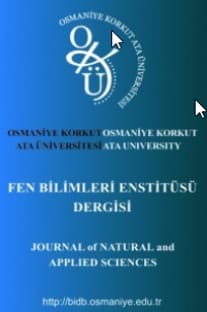Feasibility of a composite material formed with a waste granular rubber tire on racing vehicle aerodynamic wings
Yarış aracı aerodinamik kanatlarında atık granül kauçuk lastik ile oluşturulan kompozit malzemenin fizibilitesi
___
[1] Das S. Material use in automobiles, Encycl Energy 2004; 3, 859–869. doi: 10.1016/b0- 12-176480-x/00384-3.[2] Davies G. Future trends in automotive body materials, In Materials for Automobile Bodies 2007; 252–269.
[3] Ghosh M., Ghosh A., Roy A. Renewable and sustainable materials in automotive ındustry. Elsevier Ltd., 2019.
[4] Freeman WT. The use of composites in aircraft primary structure, Compos. Eng 1993; 3, 7-8, doi: 10.1016/0961- 9526(93)90095-2.
[5] Kirwan K., Wood BW. Recycling of materials in automotive engineering, In Advanced Materials in Automotive Engineering 2012; 299-314.
[6] Savage G. Formula 1 composites engineering, Eng. Fail. Anal 2010; 17 (1): 92–115. doi: 10.1016/j.engfailanal.2009.04.014.
[7] Narayana KJ., Gupta Burela R. A review of recent research on multifunctional composite materials and structures with their applications, In Materials Today: Proceedings 2018; 5(2): 5580-5590, doi: 10.1016/j.matpr.2017.12.149.
[8] O’Leary K., Pakrashi V., Kelliher D. Optimization of composite material tower for offshore wind turbine structures, Renew. Energy 2019; 140, 928 -942. doi: 10.1016/j.renene.2019.03.101.
[9] Vijayanandh R., Naveen Kumar K., Senthil Kumar M., Raj Kumar G., Naveen Kumar R., Ahilla Bharathy L. Material optimization of high speed micro aerial vehicle using FSI simulation, Procedia Comput. Sci 2018; 133, 2 -9. doi: 10.1016/j.procs.2018.07.002.
[10] Calado EA., Leite M., Silva A. Selecting composite materials considering cost and environmental impact in the early phases of aircraft structure design, J. Clean. Prod 2018; 186, 113 -122. doi: 10.1016/j.jclepro.2018.02.048.
[11] Brunner AJ. Fracture mechanics characterization of polymer composites for aerospace applications, in Polymer Composites in the Aerospace Industry 2015; 191 -230.
[12] Balakrishnan P., John MJ., Pothen L., Sreekala MS., Thomas S. Natural fibre and polymer matrix composites and their applications in aerospace engineering, in Advanced Composite Materials for Aerospace Engineering 2016; 365 - 383.Woodhead Publishing.
[13] Mohajerani A., Burnett L., Smith JV., Markovski S., Rodwell G., Rahman MT., Kurmus H., Mirzababaei M., Arulrajah A., Horpibulsuk S., Maghool F. Recycling waste rubber tyres in construction materials and associated environmental considerations: A review, Resour. Conserv. Recycl 2020; 155, 104679, doi: 10.1016/j.resconrec.2020.104679.
[14] Hetawal S., Gophane M., Ajay BK., Mukkamala Y. Aerodynamic study of formula SAE car, Procedia Eng., 2014; 97, 1198 –1207. doi: 10.1016/j.proeng.2014.12.398.
[15] Kurec K., Remer M., Mayer T., Tudruj S., Piechna J. Flow control for a car -mounted rear wing, Int. J. Mech. Sci 2018; 152, 384 –399. doi: 10.1016/j.ijmecsci.2018.12.034.
[16] Formula Student Germany, FS Rules 2020, 1.0. 2019.
- ISSN: 2687-3729
- Yayın Aralığı: Yılda 3 Sayı
- Başlangıç: 2017
- Yayıncı: Osmaniye Korkut Ata Üniversitesi
Hayvansal ürünlerde yem kaynaklı toksik maddeler
Ramazan DEMİREL, Dilek ŞENTÜRK DEMİREL
Doğu Anadolu Bölgesinde Üretilen Peynir Çeşitleri
Nuray GÜZELER, Firuza KOBOYEVA
M. Atakan AKAR, Oğuz BAŞ, Hasan SERİN, Berkay KARAÇOR, Mustafa ÖZCANLI
Yeni Doğan Buzağıların Beslenmesinde Ağız Sütünün Önemi
Static Analysis of FGM Plate-Strip with a Rectangular Hole Under Bending
Muhammad FARHAB, Madeeha AKRAM, Ijaz SALEEM, Zubair LUQMAN
Sığ Tüneller ve Yapıların Etkileşimi
A Study on Determination of The Fatty Acid Composition of Cucurbita pepo L. Seeds
Cucurbita pepo L. Tohumlarının Yağ Asidi Kompozisyonunun Belirlenmesi Üzerine Bir Çalışma
Immunomodulatory Effects of Moringa Oleifera Leaf Meal (MOLM) against Newcastle Disease in Broilers
